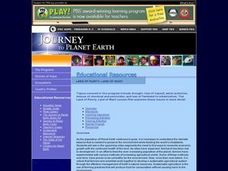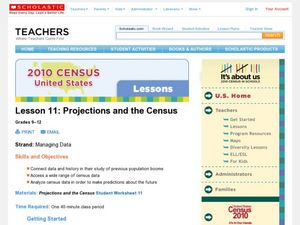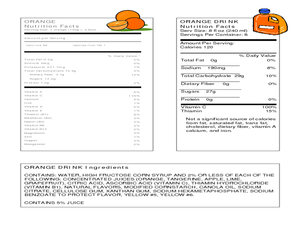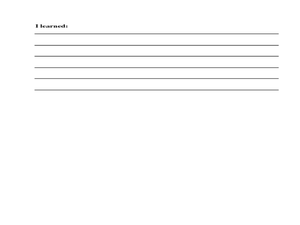Curated OER
Making a Connection
Learners research why government community workers are important to us. They work in teams to identify and illustrate the jobs and services provided by these community workers. Assessment comes from their Student Concept Maps.
Curated OER
Getting to Know You
Students read a book about understanding differences. In this getting to know you lesson, students sit in a circle, roll a ball to each other and tell one thing about themselves when they get the ball. Students read the book...
Curated OER
Olympic Values
Students learn what it is to be an athlete in the Olympics. They focus on the motto of the Olympics and make their own classroom oath to complete the lesson.
Curated OER
Land of Plenty, Land of Want
Students view a video about the state of the environment. They discover the topic of sustainable agriculture. They identify problems and how to solve them.
Curated OER
Identifying Lines: Horizontal, Vertical, and Oblique
Second graders identify horizontal, vertical, and oblique lines on a worksheet after learning them in class. They demonstrate a horizontal line with their arms while saying the word and use their arms with no talking to demonstrate...
Curated OER
Civil Rights Movement
Students identify and acquire an understanding of what the Civil Rights Movement consisted of, the issues that sparked the Movement, the people who participated and the events that occurred during the Movement. They also identify how to...
Curated OER
The Role of Individuals and Groups in the Census
Students learn why the census makes a difference. In this U.S. Census lesson plan, students describe and explain the roles that individuals, government agencies, and partner groups play in the census.
Curated OER
Projections and the Census
Students learn why the census makes a difference. In this U.S. Census lesson plan, students connect data and history in their study of previous population booms and analyze census data in order to make predictions about the future.
Curated OER
What Do You Know?
High schoolers learn why the census makes a difference. In this U.S. Census lesson plan, students demonstrate knowledge and understanding of the census and its importance.
Curated OER
Understanding Treaties: Students Explore the Lives of Yakama People Before and After Treaties
Students analyze treaties made between the US government and Native American tribes. In this government activity, students evaluate bias emotionally connect with what was gained and lost during the late 1700's. This is a 3 part activity...
Curated OER
Life During the Civil War for Women and Civilians
Students follow an overview of the American Civil War from a film, the text and/or teacher direct instruction. They create a timeline with a large map of the U.S. in the 1860's available for student reference as they do the spider activity.
Curated OER
What's the Point?
Students learn why the census makes a difference. In this U.S. Census lesson plan, students identify who uses census data and how, trace the impact of census data from Census 2000, and present findings in a graphic format.
Curated OER
Getting Active in the Census
Students learn why the census makes a difference. In this U.S. Census lesson plan, students identity ways to participate in the 2010 Census while they understand the need the need for citizen action to reduce the risk of undercounts.
Curated OER
Healthy Food is Good Food!
Students examine the difference between whole foods and junk foods. In this food lesson, students learn the definitions of whole food and junk food. They find the difference in tastes and textures of different foods by performing taste...
Curated OER
Density and Mass
Students experiment to find which liquids are more dense. In this density and mass lesson plan, students predict and then test objects to observe and measure their density. students observe which items sink and float. Students...
Curated OER
Sliders - Static and Kinetic Friction
Students work in groups to conduct experiments the demonstrate the differences between static and kinetic friction. They consider how friction affects us in our everyday lives, determine the effects of weight on friction and complete a...
Curated OER
Chinese Dragons
Students identify where China is in relation to the US. They investigate the history of dragons in Chinese culture. Students explore the nine different parts of a dragon and incorporate them into their own dragon. Student identify the...
Curated OER
The School: School Culture Across Louisiana
Students identify and research school customs and folk groups through discussion and interviews. Then they identify and learn that traditional culture exists within other cultural contexts, such as the academic world of school, and in...
Curated OER
A Slice of the Census
Learners learn why the census makes a difference. In this U.S. Census lesson plan, students examine the importance of each census question and explain the measures taken to protect the confidentiality of personal information on the census.
Curated OER
Food for Thought
Fifth graders explore the brain and what is needs. In this biology lesson plan, 5th graders will work on a series of activities that will allow them to learn about the brain, its parts, and the best foods to eat for their brain.
Curated OER
Art to Zoo: India-Where Remarkable Differences Are Ordinary
Students "visit" India to learn about its culture and the lives of children in India. In this India lesson plan, students conduct research and report on the lives of Indian children in the form of a mock interview between a journalist...
Curated OER
Telling Time in Different Time Zone
Fourth graders create clocks and complete small group activities to represent the six different times zones in the US. Using small paper plate clocks, 4th graders visually demonstrate the differences in these time zones.
Curated OER
Africa, A Look Through the Eyes of A Child
Second graders read literature about Africa, examine physical characteristics of the continent, explore animals native to Africa, and discuss distance between Africa and locations in the United States.
Curated OER
TURNING POINT IN HISTORY:The War of 1812
Students act as investigative reporters and research battles or events of the War of 1812. They write an original article, which may include a map, drawing, or illustration.























